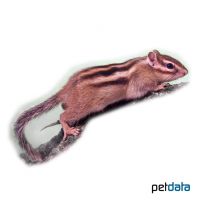Siberian Chipmunk (Tamias sibiricus)
| Siberian Chipmunk Tamias sibiricus | |
|---|---|
| Name | Siberian Chipmunk |
| Name Lat. | Tamias sibiricus |
| Synonym | Eutamias sibiricus |
| Family | Squirrels |
| Family lat. | Sciuridae |
| Order | Rodents |
| Order lat. | Rodentia |
| Origin | North Europe, North Asia |
| Climate | Temperate |
| Habitat | Forest |
| Diet | Seeds, plant matter, insects |
| Behavior | Territorial |
| Keeping | Individual, pair |
| Care Level | Easy |
| Life Span | 6-10 years |
| Protection | No |
| Metric Units | |
| Size | 13-17 cm |
| Temperature | Room temperature |
| Housing | 100 x 100 x 150 cm |
| US Units | |
| Size | 5.1"-6.7" |
| Temperature | Room temperature |
| Housing | 40" x 40" x 60" |
Distribution and habitat
The Siberian chipmunk or Burunduk belongs to the group of ground squirrels. Their range extends from northern Europe through Siberia, Mongolia, northern and central China to Korea and Japan. They live mostly in the undergrowth of mixed and coniferous forests in self-dug, branched burrows.
Maintenance
Minimum dimensions for the enclosure
| 1 animal | area: 0.6 m² | length: 1 m | height: 1 m |
An enclosure that is placed in a bright (no direct sunlight), draft-free and quiet place is recommended, with ventilation openings on the sides, and it must not be tightly closed at the top. In addition, an outdoor enclosure should be provided.
The cage should be diversely structured with roots, branches and platforms connected with ramps at different heights, as well as provide hiding and sheltering opportunities (sleeping and storage huts, cork tubes, grass caves, hammocks, etc.). They need food and drinking containers (drinking bottles), a sand bath (chinchilla sand) for grooming, nest building material (hay, pulp) and a substrate for digging. Commercially available small animal litter or a sand-peat mixture is suitable as a substrate. The bedding depth should be 20-30 cm. Nail material and a rodent stone must always be available to wear down their teeth. They should be kept at room temperature and their natural day-night rhythm should be respected.
Diet
They are mixed feeders, eating mainly vegetable food, but also need animal protein. The species-specific diet consists of chipmunk food available at specialty stores, supplemented with fresh food (apples, pears, berries, carrots, zucchini, alfalfa, dandelion), fresh twigs from unsprayed fruit trees and a mineral stone. In addition, they need some animal protein, such as live insects (crickets, house crickets, mealybug larvae), cottage cheese, a hard-boiled hen's egg or insect food for hedgehogs. Occasionally, dried fruits such as raisins, rose hips (high in vitamin C) and nuts can be fed. Drinking water must always be available in hanging bottles or in stable, open containers and, like food, must be offered fresh daily.
A varied diet promotes health and prevents deficiency symptoms
Behaviour and compatibility
Chipmunks are diurnal. They live in loose colonies, but within them as loners and each animal has its territory. Therefore, they should rather be kept individually. For pair keeping, several sleeping houses and a well-structured cage are a prerequisite. At the first signs of incompatibility, the animals should be separated immediately.
Reproduction and breeding
The distance between anus and urethral outlet is larger in males. In sexually mature males, testicles are usually visible.
The gestation period is 28-31 days. A litter usually consists of 4-6 young, which are born naked, blind and deaf. Eyes open after 26-29 days and they leave the nest around day 36. The young are suckled for 7-8 weeks and can then be separated from their mother. They are sexually mature after 10-11 months. Life expectancy can be 6-10 years.
Important
The chipmunk (Burunduk) is the only species found outside of North America. In the wild, they hibernate, interrupting from time to time to eat food and defecate and urinate. Even in an enclosure at room temperature, they may experience periods of lethargy during which they remain in their roost for days at a time. They must not be disturbed during this time
They are flight animals and need adequate retreat and hiding places. They must not be grabbed or pulled by the tail, as this can cause serious injuries. Special attention must be paid to thorough hygiene and contamination must be removed regularly
Further literature can be found in your pet store.
References
Text: petdata; Image: petdata
Source: BEISSWENGER (2008): Streifenhörnchen, GU Verlag; W. PUSCHMANN, D. ZSCHEILE, K. ZSCHEILE (2009): Zootierhaltung - Tiere in menschlicher Obhut: Säugetiere, Verlag Harri Deutsch; BMEL (2014): Gutachten über Mindestanforderungen an die Haltung von Säugetieren
- Gemäß § 21 Abs. 5 Tierschutzgesetz idgF
